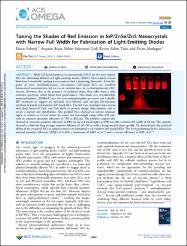| dc.contributor.author | Soheyli, Ehsan | |
| dc.contributor.author | Bicer, Aysenur | |
| dc.contributor.author | Ozel, Sultan Suleyman | |
| dc.contributor.author | Tiras, Kevser Sahin | |
| dc.contributor.author | Mutlugun, Evren | |
| dc.date.accessioned | 2024-02-01T13:22:47Z | |
| dc.date.available | 2024-02-01T13:22:47Z | |
| dc.date.issued | 2023 | en_US |
| dc.identifier.issn | 2470-1343 | |
| dc.identifier.other | WOS:001140494700001 | |
| dc.identifier.uri | https://doi.org/10.1021/acsomega.3c05580?urlappend=%3Fref%3DPDF&jav=VoR&rel=cite-as | |
| dc.identifier.uri | https://hdl.handle.net/20.500.12573/1914 | |
| dc.description.abstract | While Cd-based luminescent nanocrystals (NCs) are the most mature NCs for fabricating efficient red light-emitting diodes (LEDs), their toxicity related limitation is inevitable, making it necessary to find a promising alternative. From this point of view, multishell-coated, red-emissive InP-based NCs are excellent luminescent nanomaterials for use as an emissive layer in electroluminescent (EL) devices. However, due to the presence of oxidation states, they suffer from a wide emission spectrum, which limits their performance. This study uses tris-(dimethyl-amino)-phosphine (3DMA-P) as a low-cost aminophosphine precursor and a double HF treatment to suggest an upscaled, cost-effective, and one-pot hot-injection synthesis of purely red-emissive InP-based NCs. The InP core structures were coated with thick layers of ZnSe and ZnS shells to prevent charge delocalization and to create a narrow size distribution. The purified NCs showed an intense emission signal as narrow as 43 nm across the entire red wavelength range (626-670 nm) with an emission quantum efficiency of 74% at 632 nm. The purified samples also showed an emission quantum efficiency of 60% for far-red wavelengths of 670 nm with a narrow full width of 50 nm. The samples showed a relatively long average emission lifetime of 50-70 ns with a biexponential decay profile. To demonstrate the practical ability of the prepared NCs in optoelectronics, we fabricated a red-emissive InP-based LEDs. The best-performing device showed an external quantum efficiency (EQE) of 1.16%, a luminance of 1039 cd m(-2), and a current efficiency of 0.88 cd A(-1). | en_US |
| dc.language.iso | eng | en_US |
| dc.publisher | AMER CHEMICAL SOC | en_US |
| dc.relation.isversionof | 10.1021/acsomega.3c05580 | en_US |
| dc.rights | info:eu-repo/semantics/openAccess | en_US |
| dc.subject | QUANTUM DOTS | en_US |
| dc.subject | EFFICIENT | en_US |
| dc.title | Tuning the Shades of Red Emission in InP/ZnSe/ZnS Nanocrystals with Narrow Full Width for Fabrication of Light-Emitting Diodes | en_US |
| dc.type | article | en_US |
| dc.contributor.department | AGÜ, Mühendislik Fakültesi, Elektrik - Elektronik Mühendisliği Bölümü | en_US |
| dc.contributor.authorID | 0000-0002-1403-7934 | en_US |
| dc.contributor.authorID | 0000-0001-5523-4769 | en_US |
| dc.contributor.authorID | 0000-0003-3715-5594 | en_US |
| dc.contributor.institutionauthor | Soheyli, Ehsan | |
| dc.contributor.institutionauthor | Bicer, Aysenur | |
| dc.contributor.institutionauthor | Ozel, Sultan Suleyman | |
| dc.contributor.institutionauthor | Mutlugun, Evren | |
| dc.identifier.volume | 8 | en_US |
| dc.identifier.issue | 42 | en_US |
| dc.identifier.startpage | 39690 | en_US |
| dc.identifier.endpage | 39698 | en_US |
| dc.relation.journal | ACS OMEGA | en_US |
| dc.relation.tubitak | 20AG026 | |
| dc.relation.publicationcategory | Makale - Uluslararası Hakemli Dergi - Kurum Öğretim Elemanı | en_US |


















